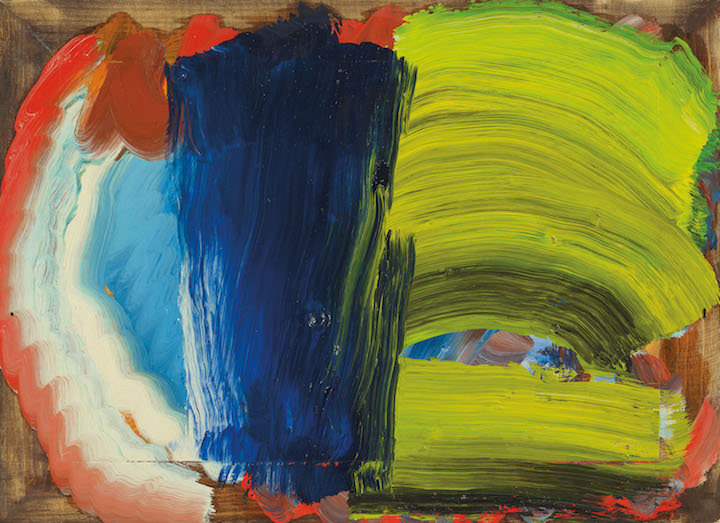‘To Secunderabad,’ Howard Hodgkin wrote in a travel journal in 1970. ‘Gin and lime at lunchtime. Rain in the afternoon with exactly matching Golconda skies – navy blue and white lined with receding pink.’ This entry sounds like the note for a future Hodgkin painting: a moment in time, a sense of place, skies and weather, distinctive colours. Hodgkin first went to India in 1964, when he was 32, and thereafter he visited the country almost every year, often for extended periods. His interest in the subcontinent arose from a passion for Mughal and Rajput miniatures, and three examples from his remarkable collection are shown alongside the artist’s own paintings inspired by India in this beautifully mounted exhibition.
The earliest painting in the show, Mrs Acton in Delhi (1967–71), depicts the wife of the British Council’s representative in the city reclining on a balcony against the backdrop of a lurid sky. Like many of his early ‘portraits’, this one occupies an uncertain borderland between the figurative and the abstract and seems influenced more by Pop art than Indian miniatures. Hodgkin said that his deployment of horizontal bands of colour in Bombay Sunset (1972–73) was ‘the only thing I can think of in any of my pictures which has a specific likeness to an Indian miniature’, but this painting is more significantly the earliest one on show here in his recognisable mature style. The exhibition’s chronological arrangement allows one to note that the vivid burnt orange stippling on a green background seen in the topmost band in this picture – an effect often used thereafter in different, but equally punchy colour combinations – refers back directly to the floor tiles on Mrs Acton’s balcony. And it may be no coincidence that green and orange are two of the colours on the Indian flag.
Mrs Acton in Delhi (1967–71), Howard Hodgkin. Courtesy Gagosian; © Howard Hodgkin
Indian miniatures led Hodgkin to India, but once he was there it was the country itself rather than its art that fed into his work. As he said of Bombay Sunset: ‘A sunset in Bombay really does – curiously enough – look like that,’ and the subcontinent’s dramatic skies, lush greenery and everyday use of bright colour in domestic architecture were a natural fit with Hodgkin’s developing style. The evolution of palm trees that can be traced in three paintings, from the heavily outlined geometric shapes of In a Hotel Garden (1974), through the seemingly rapid brushwork of In the Garden of the Bombay Museum (1978–82), to the few gestural strokes of Summer Rain (2002–13), give a sense of Hodgkin gradually relaxing under Indian influence. He would return to these trees frequently, notably in the set of hand-coloured prints shown at the Waddington Galleries in 1991, and while no works on paper are on display here, they can be seen in the forthcoming ‘India on Paper’ exhibition at the Victoria Art Gallery in Bath.
Despite curating the Tate’s ‘Six Indian Painters’ exhibition in 1982, Hodgkin did not particularly like contemporary Indian art. Bhupen Khakhar was the exception. Perhaps drawn to each other by a shared sexuality and sense of colour, the two men became close friends and Hodgkin bought several of Khakhar’s best paintings. It seems odd, therefore, that From the House of Bhupen Khakhar (1975–76) is one of the less successful paintings at the Hepworth Wakefield, so uncertain in structure and its use of colour that it looks like a sketch for a painting rather than a finished piece. Infinitely better is In the Studio of Jamini Roy (1976–79), and it is perhaps significant that the great Bengali painter had already died when Hodgkin visited his workplace: the recent exhibition at the National Portrait Gallery showed that Hodgkin’s portraits are generally less convincing than those which evoke an atmosphere.
In the garden of the Bombay Museum (1978–82), Howard Hodgkin. Courtesy Gagosian; © Howard Hodgkin
‘Painting India’, on the other hand, provides almost unalloyed pleasure. Although not planned as a retrospective, it occasionally gives a sense of an artist looking back over his life: the domestic triptych Indian Veg (2013–14), for example, nods towards a more notionally figurative period in Hodgkin’s career, while the almost monochrome Night Thoughts (2014–15) echoes the spectacular black and white mural he created for the British Council’s Delhi headquarters in 1993. Having previously spent time in India ‘sopping up impressions’ (as Bruce Chatwin put it), which were then turned into paintings back in England, in his last years Hodgkin painted in a studio in Mumbai. Aware of encroaching age and infirmity, he produced work with a new speed and freedom, a characteristic example being some eye-popping smears of bright red and yellow across a wooden board, aptly titled Now (2015–16). He was painting as well as he ever had: the vibrancy of Letters from Bombay (2012–14) and the deceptively sombre greens and blacks of From the Terrace, Bombay (2015–16) have all the energy and bravura of an artist still discovering the world.
‘Howard Hodgkin: Painting India’ is at the Hepworth Wakefield from 1 July–8 October.
From the September issue of Apollo. Preview and subscribe here.
